Introducing 10 new features in Quarkus Tools for Visual Studio Code 1.3.0
Quarkus Tools for Visual Studio Code 1.3.0 has been released on the VS Code Marketplace , the first release of the year.
Alongside various bug fixes, this release focused on introducing VS Code support that
accompanies new Quarkus features like application.yaml support,
server-side templating support and the Quarkus 1.2 kebab-case @ConfigProperties property names.
For a list of all changes, please refer to the changelog.
Watch a demo video of all features presented in this article:
New Features
URL CodeLens for RESTEasy JAX-RS GET methods
When editing a resource class while the current Quarkus application is running in
development mode (./mvnw compile quarkus:dev or ./gradlew quarkusDev), there
are now CodeLenses that provide the URL for the GET endpoints.
This feature takes into account the path name and the HTTP server port from your
application.properties file in order to create the URL.
CodeLensのURLをクリックすると、デフォルトのブラウザでURLが表示されます。
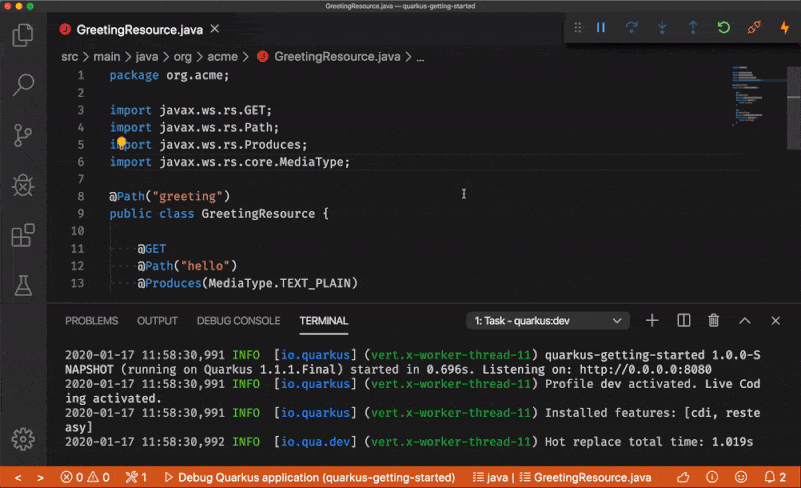
Once the Quarkus application stops running, the CodeLens URL will no longer appear.

Please keep in mind, CodeLens in VS Code are only updated when certain events happen.
If the URL CodeLens does not appear, some easy ways to trigger a CodeLens update
are by switching tabs or by starting to type in any file. Also make sure that the
quarkus.tools.codeLens.urlCodeLensEnabled VS Code setting is set to true.
Hover support for @ConfigProperty name in Java sources
Hovering over the name value in a @ConfigProperty annotation will now display
the value of the hovered property. Currently, the value will either come from
the application.properties file, or the default value field.
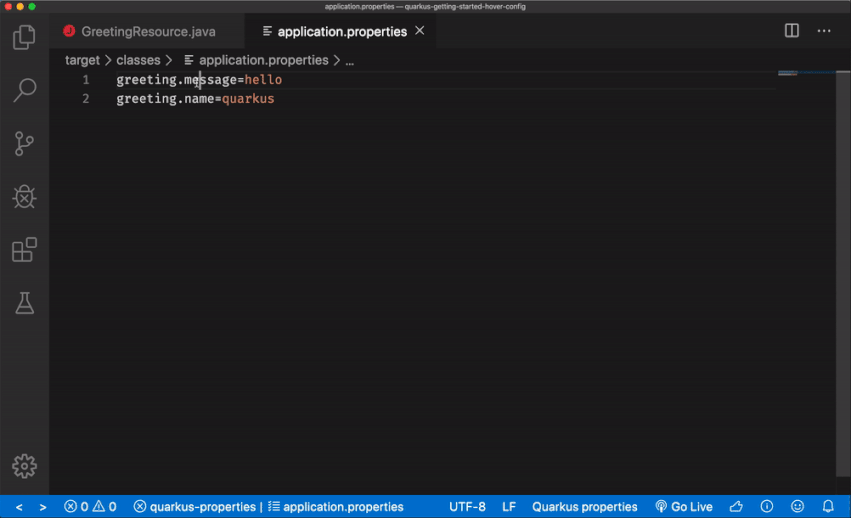
Language support for Kubernetes, Openshift, S2i and Docker properties
There is now completion, hover, documentation and validation for kubernetes.*,
openshift.*, s2i.*, docker.* properties coming from the
Kubernetes Quarkus extension.
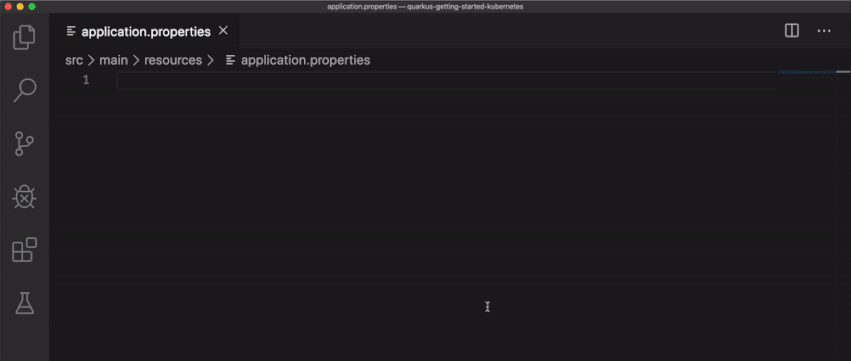
Language support for MicroProfile REST Client properties
Likewise, there is now completion, hover, documentation and validation for the MicroProfile properties from REST Client.
After registering a REST client using @RegisterRestClient like so:
package com.mycompany.remoteServices;
@RegisterRestClient
public interface MyServiceClient {
@GET
@Path("/greet")
Response greet();
}The related MicroProfile Rest config properties will have language feature support (completion, hover, validation, etc.).
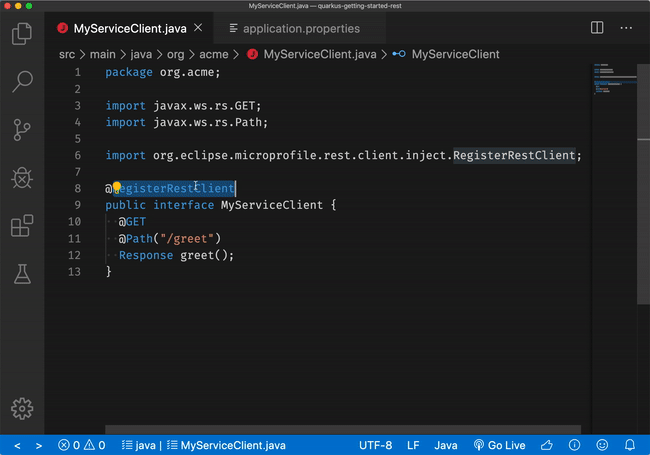
More information about using the MicroProfile REST Client with Quarkus is available on the Quarkus guides here.
YAML support (experimental)
The release of
Quarkus 1.1.0.Final,
brought
YAML configuration support,
meaning that you can now configure your Quarkus application with either an application.yaml
or application.properties file (but try to stick with one!).
As a result, there is now completion support for application.yaml files. Similarly to
application.properties, the completion options in application.yaml will be in sync with
the Quarkus extensions that are currently available to the current project (in pom.xml or
build.gradle), therefore giving you only the relevant completion options.
This feature depends on the VS Code YAML extension. If it is not currently installed, a new prompt will propose to install it.
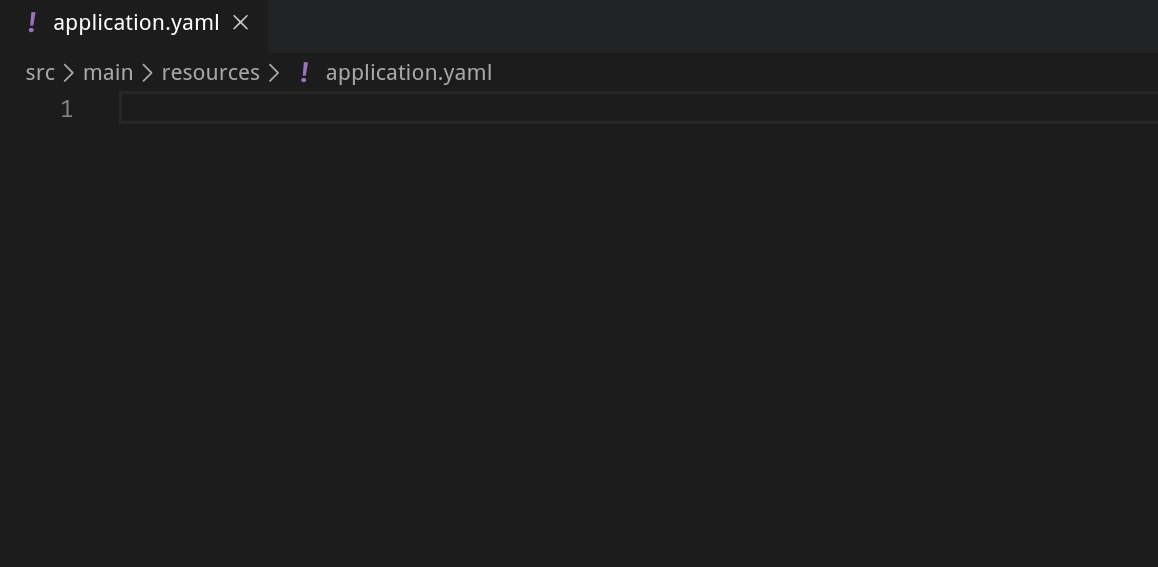
Language feature support for the application.yaml file is in its experimental stages.
Compared to application.properties support, there are some limitations:
-
Go to definition support
-
Code action support
-
Automatic completion for default values
-
Limited config property and value validation support
Quick Fix to add unknown property namespaces to ignore
There is now a new Quick Fix that helps exclude large groups of unknown properties from unknown property validation, as long as they share the same parent namespace.
For example, if your application.properties file contains four properties with an
Unknown property error like so:
# All four properties cause an 'Unknown property' error
unknown.test1=a
unknown.test2=b
unknown.test3=c
unknown.test4=dIgnoring all four properties from unknown property validation is easily done by
the Quick Fix, which adds unknown.* to the quarkus.tools.validation.unknown.excluded
workspace configuration array.
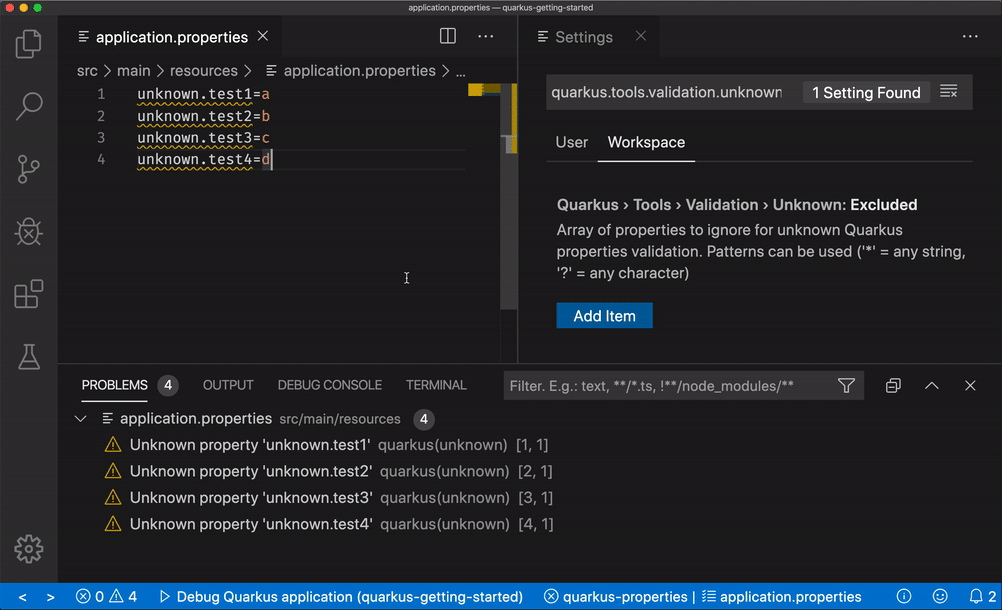
Go to definition support for enum values in application.properties
Until now, Go to definition was only supported for config property keys and not the values. This release brings the Go to definition feature for enum values.
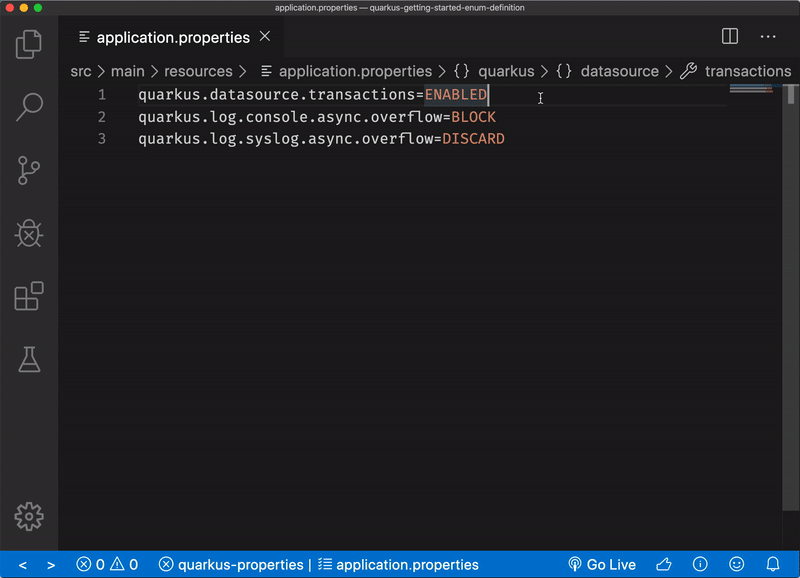
New extensions descriptions toggle
As the number of Quarkus extensions continues to rise, the new extension descriptions in
the extension selection prompts helps recognize and discover new extensions.
The extension selection prompt appears when selecting Quarkus extensions from the
Quarkus: Generate a Quarkus project and Quarkus: Add extensions to current project wizards.

There is also a new button on the top right of the prompt that toggles whether or not the extension descriptions should appear.
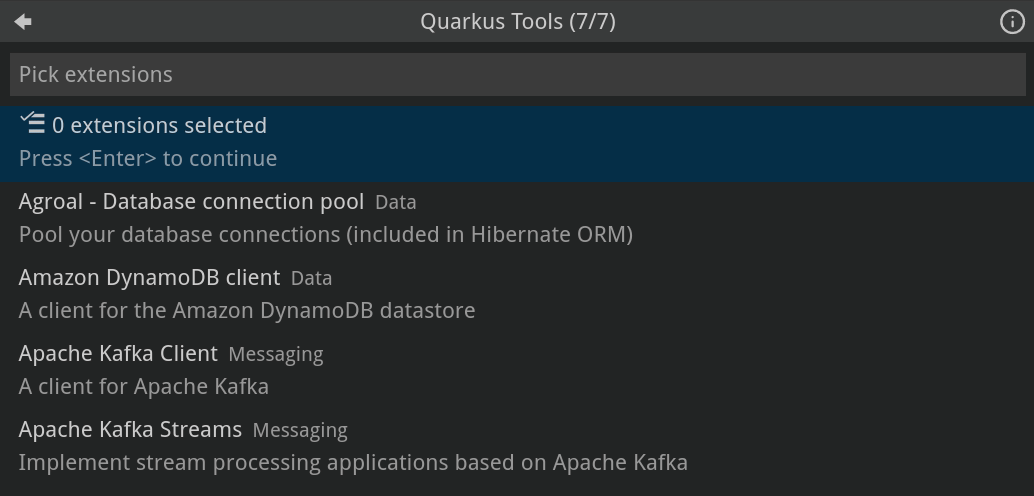
Different ways to open a new Quarkus project
After creating a new project with the Quarkus: Generate a Quarkus project wizard there
is now a new prompt that asks you how the new project should be opened.
The following tables describe the before and after changes.
| Scenarios | Ways to open the new project |
|---|---|
All scenarios |
Open project in a new window |
| Scenarios | Ways to open the new project | |
|---|---|---|
A workspace is open |
Open project by adding to current workspace |
Open project in a new window |
An editor is open |
Open project in the current window |
Open project in a new window |
Nothing is open |
Open project in the current window |
|
Here is one of the scenarios in action, when a new project has been generated while a workspace is already open.
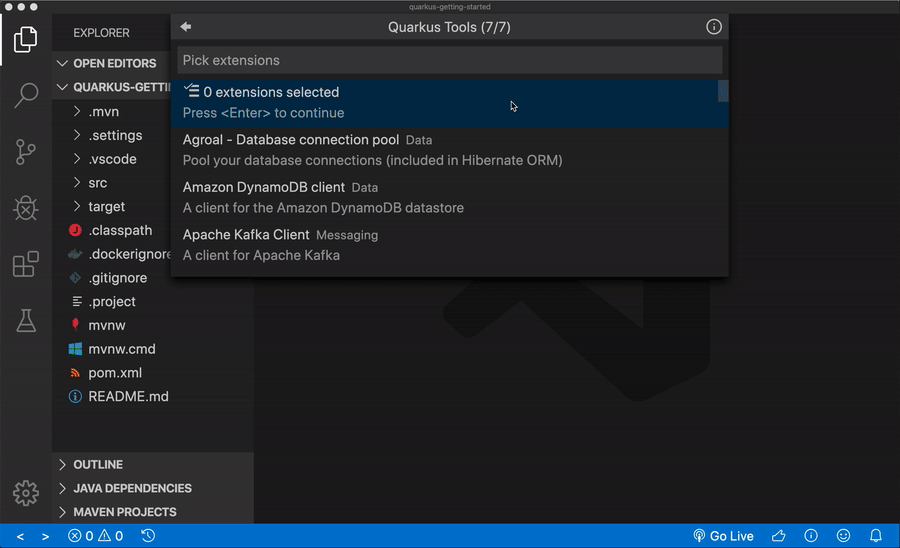
Syntax highlighting for Qute languages
Qute
is a new server-side templating engine created with Quarkus in mind.
This release brings new Qute Language Modes in VS Code: Qute HTML, Qute JSON, Qute YAML
and Qute Text. The new language modes are automatically applied to your current file, if
your file’s file extensions is .qute.html, .qute.json, .qute.yaml and .qute.txt
respectively.
Thanks to the new language modes, Qute-specific syntax highlighting and commenting are now provided.
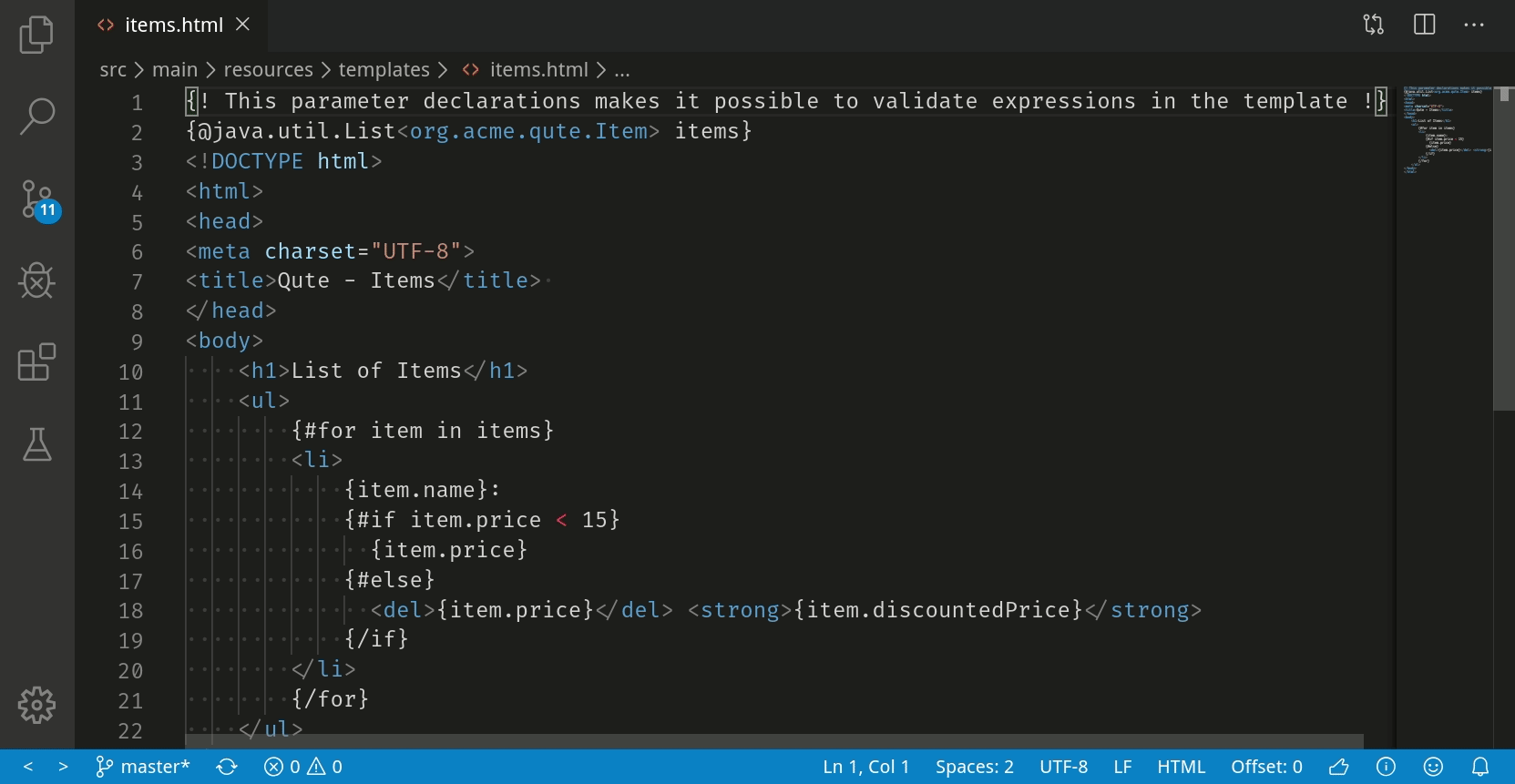
For more information about the Qute templating engine, please refer to the Quarkus templating engine guide.
将来
This wraps up the new major features in this release. If you have any questions, suggestions or feedback, by all means please open a GitHub issue.
For future releases we are aiming to improve
language support for MicroProfile properties, application.yaml and Qute languages.
お読みいただきありがとうございました。次のリリースをお待ちください!
リンク
-
VS Code Marketplace link: https://marketplace.visualstudio.com/items?itemName=redhat.vscode-quarkus
-
GitHubレポジトリ: https://github.com/redhat-developer/vscode-quarkus
-
GitHubの課題の作成: https://github.com/redhat-developer/vscode-quarkus/issues/new
-
変更履歴: https://github.com/redhat-developer/vscode-quarkus/blob/master/CHANGELOG.md
-
Version 1.2.0 blog post: https://quarkus.io/blog/vscode-quarkus-1.2.0/
-
Version 1.1.0 blog post: https://quarkus.io/blog/vscode-quarkus-1.1.0
-
Version 1.0.0 blog post: https://quarkus.io/blog/quarkus-developer-joy-for-vs-code
